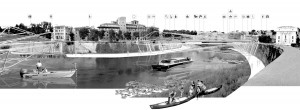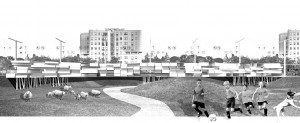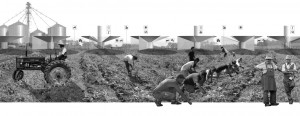Hackable Infrastructures is an ongoing research and design initiative mining emergent infrastructures and contemporary urban protocols.
Metropolitan Rome is a vibrant and dynamic collision of the pressures of globalization, urbanization, and migration. The form of the city is fluid, and a wide array of informal settlements and structures persist within the formal city fabric. In the periphery, much of the urban form is ‘unplanned,’ driven by the ever-changing conditions of the market, speculative development, and ‘abusive’ construction. Informal settlements, once a negligible and overlooked part of the city, are escalating in scale and intensity, and are dictating future development to a large extent. In this ever-shifting milieu, the planning structures of the municipality must respond to increasingly complex flows of populations, capital, and commerce.
The project interrogates the margins of the contemporary city, finding new models for viable, productive urban environments in forgotten, underused, neglected, and emerging zones at the city’s edge. Throughout the city there exist a variety of examples where innovation, improvisation, appropriation, and informal activity is redefining the character of urban life. Through a series of investigative case studies, we distill a set of successful developmental tactics, extrapolating the findings of the research through speculative architectural, infrastructural, and urban designs.
The project fostered a broad dialogue in the reconsideration of the urban periphery, engaging local architects, planners, community advocates, community leaders, and students to help define the city’s most pressing needs, and by proposing actionable, participatory design and construction strategies that might help to solve them. Our direct involvement in a series of public events including lectures, workshops, exhibits, and conferences has extended the project’s reach.
The research and design proposals were compiled in printed form for publication, and as a multimedia installation for an exhibit at the American Academy in Rome in 2011
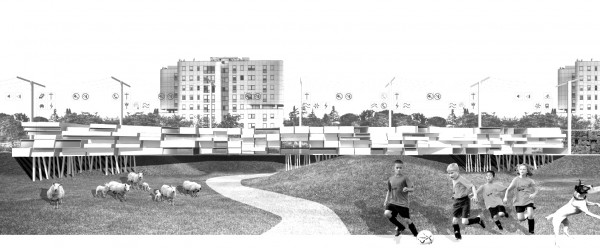 Sound Barrier Housing negotiates an unlikely partnership between competing development pressures.
Sound Barrier Housing negotiates an unlikely partnership between competing development pressures.
As the city expands, its patterns of wasteful land use are self-perpetuating. The need for new residential, commercial, and business centers for a growing population is exacerbated by the challenges of finding available and desirable land. High speed traffic corridors create a visual and auditory nuisance, and a safety hazard that prohibits a sustainable level of urban density and development. Protective guardrails and acoustic barriers are vital to the success of future development.
Repurposing much-needed municipal investment in the protection and acoustical isolation of its several highway corridors, the project proposes a model for an inhabitable sound barrier. In its association with major public and private transportation networks, and its historic function as primary corridor for electrical service, drainage, and telecommunications, the highway corridor provides an ideal site for servicing communities in need.
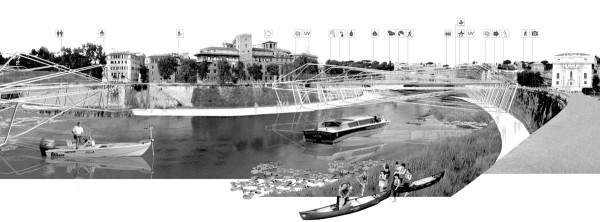 Filter Bridge couples informal economies with infrastructure for water and sanitation.
Filter Bridge couples informal economies with infrastructure for water and sanitation.
The increasing density of the urban core is putting ever-greater pressures on the city’s ability to provide basic water services and safe passage for its residents and visitors. With the growing local population, and increased seasonal demands by tourists and visitors, the city’s water supply is in desperate need of an upgrade. Public facilities are few and far between, and potable drinking water is a luxury to be bottled and sold. The city’s great liquid asset, the Tiber River, has dwindled in its civic importance, as its major crossings are choked with automobile traffic, its embankments barely noticed by casual visitors and citizens alike. Once a connective force for the landscape of Rome, the River is now highly divisive, slicing communities in disparate halves. The power of the river must once again be harnessed.
The project proposes infrastructural armatures, acting as a backbone for water filtration systems, pedestrian bridges, and informal markets. An array of filtration loops filter river water with carbon, ultraviolet, and botanical technologies, providing gray water for public restrooms and shower facilities, and drinking water for the city’s visitors and residents. Composed of structural fiber composite tubing, the loops serve as a support system for additional development. The height of the loop is appropriated as informal commercial space, with modular shelving, tables, and hinged storage units serving as display space for transactions with local crafts and trades. Users find a whole new way to navigate the city, from water level, where natural filtration ponds and gray-water storage tanks serve a new ecology of river plant- and wildlife.
 Agri-Collector occupies rural margins with agricultural services and emerging markets.
Agri-Collector occupies rural margins with agricultural services and emerging markets.
The city’s food supply is increasingly dependent on remote sources, while peripheral agricultural land lies under-utilized and underproductive. Inefficient management of water resources, an aging rural population, and the lack of diversification of local crafts industry negatively affect rural agricultural production, to the detriment of the city’s sustainable growth. To maintain its current levels of consumption, and compete with the global metropolis of tomorrow, the city must advance its energy infrastructure, while ensuring the responsible development of its exurban periphery into more locally-networked centers of agricultural production.
The project proposes storage and distribution structures at the margins of farmland, supporting the production and distribution of local food supply. Solar plates, thermal stacks, rain water collectors and geothermal wells are accommodated in one multipurpose structure, an inverted funnel that gathers and stores. The units harvest energy efficiently and sustainably, collecting power for emergency use, and feeding overages back into the metropolitan grid.

